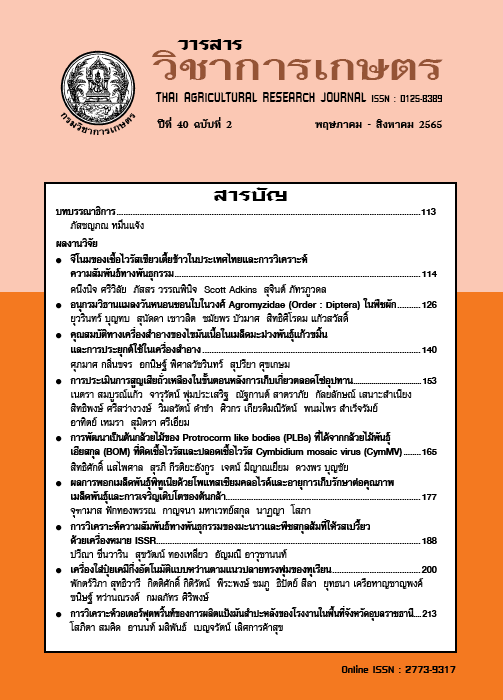คุณสมบัติทางเครื่องสำอางของไขมันเนื้อในเมล็ดมะม่วงพันธุ์แก้วขมิ้น และการประยุกต์ใช้ในเครื่องสำอาง
DOI:
https://doi.org/10.14456/thaidoa-agres.2022.12คำสำคัญ:
เมล็ดมะม่วง, แก้วขมิ้น, ไขมัน, ไทโรซิเนส, ไฮยารูลอนิเดส, อีลาสเตส, คอลลาจีเนส, โลชันบทคัดย่อ
งานวิจัยนี้มีวัตถุประสงค์เพื่อศึกษา คุณสมบัติทางเครื่องสำอางที่สำคัญจากไขมันเนื้อ ในเมล็ดมะม่วงพันธุ์แก้วขมิ้น ซึ่งเป็นส่วนเหลือ ทิ้งจากอุตสาหกรรมแปรรูปมะม่วง และประยุกต์ ใช้เป็นส่วนประกอบให้ความชุ่มชื่นในสูตรการ ผลิตโลชั่นทาผิวผลการทดลองพบว่า เนื้อในเมล็ด มะม่วงพันธุ์แก้วขมิ้นมีไขมันเป็นองค์ประกอบร้อย ละ 7.25 โดยน้ำหนัก ไขมันที่สกัดได้ประกอบด้วย กรดไขมันอิ่มตัวและไม่อิ่มตัวร้อยละ 37.9 และ 62.1 ตามลำดับ และมีจุดหลอมเหลวที่ 36.7 °ซ. เมื่อตรวจสอบคุณสมบัติทางเครื่องสำอาง พบว่า มีความสามารถในการยับยั้งปฏิกิริยาออกซิเดชัน มีค่า SC50 เท่ากับ 1.02 มก./มล. นอกจากนี้ยัง มีความสามารถในการยับยั้งกิจกรรมของเอนไซม์ ไทโรซิเนสที่เป็นสาเหตุความหมองคล้ำของผิว และเอนไซม์ไฮยารูลอนิเดสที่ทำหน้าที่ในการย่อย กรดไฮยาลูรอนิคที่ทำหน้าที่กักเก็บความชุ่มชื่นใต้ ผิวหนัง โดยมีค่า IC50 เท่ากับ 0.47 และ 0.14 มก./มล. ตามลำดับ และยังมีความสามารถใน การยับยั้งกิจกรรมของเอนไซม์อีลาสเตสและ คอลลาจีเนสที่เป็นสาเหตุของริ้วรอยและความ เหี่ยวย่น โดยมีค่าIC50 เป็น 6.26 และ4.77 มก./มล. ตามลำดับ เมื่อใช้ไขมันเนื้อในเมล็ดมะม่วงเป็น ส่วนประกอบที่ให้ความชุ่มชื่นในผลิตโลชั่นทาผิว ร้อยละ 1.0-3.0 โดยน้ำหนัก พบว่า โลชั่นทาผิว มีค่าความเป็นกรด-ด่าง 7.38-7.42 เป็นไปตาม มาตรฐาน มอก. 478-2555 และมีแรงผลักของ ประจุระหว่างอนุภาค (zeta potential) น้อย กว่า 30 มิลลิโวลท์ นอกจากนี้การเพิ่มขึ้นของ ไขมันเนื้อในเมล็ดมะม่วงในสูตรการผลิตความ เข้มข้นร้อยละ 1.0 -3.0 ส่งผลให้โลชั่นมีความ แน่นเนื้อและดัชนีความหนืดเพิ่มขึ้น และพบว่า ไม่ก่อให้เกิดอาการแพ้และระคายเคืองกับผิวหนัง โดยมีค่า Mean cumulative irritation index (M.C.I.I value) ต่ำกว่า 0.25 จากผลการทดลอง เห็นได้ว่า ไขมันเนื้อในเมล็ดมะม่วงพันธุ์แก้วขมิ้น มีคุณสมบัติเหมาะสมที่จะใช้เป็นส่วนผสมใน ผลิตภัณฑ์เครื่องสำอาง หากนำเมล็ดมะม่วงซึ่ง เป็นของเหลือจากอุตสาหกรรมแปรรูปไปสกัดเป็น ไขมันเนื้อในเมล็ดมะม่วงก็จะสร้างมูลค่าเพิ่มและ ลดของเสียจากอุตสาหกรรมแปรรูปได้
เอกสารอ้างอิง
สิรินมาส คัชมาตย์. 2553. การใช้สมุนไพรในผลิตภัณฑ์เครื่องสำอาง. ข่าวสารด้านยาและผลิตภัณฑ์สุขภาพ. 13 (4): 111-112.
สำนักงานนโยบายและยุทธศาสตร์การค้า. 2564. วิเคราะห์สถานการณ์เศรษฐกิจการค้าไทยรายภูมิภาค ประจำเดือนพฤษภาคม 2654. สำนักงานนโยบายและยุทธศาสตร์การค้า กระทรวงพาณิชย์. 7 หน้า.
สำนักงานมาตรฐานผลิตภัณฑ์อุตสาหกรรม. 2555. มาตรฐานผลิตภัณฑ์อุตสาหกรรม ผลิตภัณฑ์ทาบำรุงผิว มอก. 478-2555. สำนักงานมาตรฐานผลิตภัณฑ์อุตสาหกรรม กระทรวงอุตสาหกรรม. 7 หน้า.
Abdel-Razik, M.M, I.S. Ashoush and N.M.N. Yassin. 2012. Characteristics of mango seed kernel butter and its effects on quality attributes of muffins. Alex. J. Food Sci. Technol. 9(2): 1–9.
Bentley, R. 1957. Preparation and analysis of kojic acid. Method Enzymol. 3:238-241.
Buchanan M.D., K.K. Stenerson, and L.M. Sidisky. 2011. SLB-IL111 for Fatty Acid Methyl Ester (FAME) Applications. Technical Report SIGMA-ALDRICH. 8 p.
Fernandez-Stark, K., V. Couto and G. Gereffi. 2017. The mango global value chain. pp. 2-18. In The Philippines in the Mango Global Value Chain. The Duke University Center on Globalization, Governance & Competitiveness.
González, S., M. Fernádez-Lorente and Y. Gilaberte-Calzada. 2008. The latest on skin photoprotection. Clin. Dermatol. 26(6): 614-626.
Greenspan A, C. Loesche, N. Vendetti, K. Georgeian, R. Gilbert, M. Poncet, M.D. Baker and P. Soto. 2003. Cumulative irritation comparison of adapalene gel and solution with 2 tazarotene gels and 3 tretinoin formulations. Cutis. 72(1): 76-81.
Gunstone, F.D. 2006. Minor specialty oils. pp. 91-126. In Nutraceutical and Specialty Lipids and Their Co-Products. CRC Taylor & Francis Group, Florida, USA.
Jahurul, M.H.A., S.M. Zaidul, F. ISahena, M.S. Sharifudin, N.N. Norulaini, M.E. Ali, M. Hasmadi, K. Ghafoor, W. Zzaman and A.K.M. Omar. 2018. Physicochemical properties of cocoa butter replacers from supercritical carbon dioxide extracted mango seed fat and palm oil mid-fraction blends. Int. Food Res. J. 25 (1): 143–149.
Jenkins, G. 2002. Molecular mechanisms of skin ageing. Mech. Ageing Dev. 123(7): 801-810.
Kim, S.J., S. Sancheti, S.S. Sancheti, B.H. Um, S.M. Yu and S.Y. Seo. 2010. Effect of 1,2,3,4,6-penta-o-galloyl--d-glucose on elastase and hyaluronidase activities and its type II collagen expression. Acta Pol. Pharm. 67(2): 145-150.
Lee, S.H., S. Sancheti, S. Sancheti and S.Y. Seo. 2009. Potent antielastase and Antityrosinase activities of Astilbe chinensis. Am. J. Phamacol. Toxicol. 4(4): 127-129.
Manosroi, A., K. Boonpisuttinant, S. Winitchai, W. Manosroi and J. Manosroi. 2011. Free radical scavenging and tyrosinase inhibition activity of physic nut (Jatropha curcas Linn.) seed oil entrapped in niosomes. Curr. Nanosci. 7(5): 825-829.
Mirhosseini, H., Y. Salmah, S.A.H. Nazimah and C.P. Tan. 2007. Solid-Phase microextraction for headspace analysis of key volatile compounds in orange beverage emulsion. Food Chem. 105: 1659–1670.
Miyazawa, M. and N. Tamura. 2007. Inhibitory compound of tyrosinase activity from the sprout of Polygonum hydropiper L. (Benitade). Biol. Pharm. Bull. 30(3): 595-597.
Mostafa, U.E. 2013. Phenolic compounds and antioxidant potential of mango peels and kernels (Mangifera indica L.) on the frying oil stability, lipid profile and activity of some antioxidant serum enzymes in rats. J. Am. Sci. 9 (11): 371-378.
Naik, B. and V. Kumar. 2014. Cocoa butter and its alternatives: A review. J. Bioresour. Eng. Technol. 1: 7-17.
O'Brien, R.D. 2008. Fats and Oils: Formulating and Processing for Applications. 3rd Edition. CRC press, Taylor & Francis Group, Florida, USA. 680 p.
Oluwaseyi, M.I. 2015. Shea butter: an opposite replacement for trans-fat in margarine. J. Nutr. Food Sci. 11: 001.
Palaniswamy, K.P., C.R. Muthukrishna and K.G. Shanmugavelu. 1974. Physicochemical characteristics of some varieties of mango. Indian Food Packer. 28(5): 12-18.
Pandey A. and S. Tripathi. 2014. Concept of standardization, extraction and pre phytochemical screening strategies for herbal drug. J. Pharm. Phytochem. 2(5): 115-119.
Panzella, L. and A. Napolitano. 2019. Natural and bioinspired phenolic compounds as tyrosinase inhibitors for the treatment of skin hyperpigmentation: Recent advances. Cosmetics. 6(4): 57.
Park, H., B.Y. Sin and H.P. Kim. 2005. Inhibition of collagenase by anti-inflammatory synthetic flavones. J. Appl. Pharm. 14: 36-39.
Puravankara, D., V. Bohgra and R. S. Sharma. 2000. Effect of antioxidant principles isolated from mango (Mangifera indica L.) seeds kernels on oxidative stability of buffalo ghee (butter-fat). J. Sci. Food Agri. 80(4): 522-526.
Ranasinghe P., G.A.S. Premakumara, C.D. Wijayarathna and W.D. Ratnasooriya. 2015. Antioxidant activity of Caryota urens L. (Kithul) Sap. Trop. Agric. Res. 24 (2): 117–125.
Schiber, A., N. Beradini and R. Carle. 2003. Identification of flavonol and xanthone glycosides from mango (Mangifera indica L. Cv. “Tommy Atkins”) Peels by High-Performance Liquid Chromatography-Electrospray Ionization Mass Spectrometry. J. Agri. Food Chem. 51(17): 5006-5011.
Sutthiwanjampa, C. and S.M. Kim. 2015. Production and characterization of hyaluronidase and elastase inhibitory protein hydrolysate from Venus clam. Nat. Prod. Res. 29(17): 1614-1623.
Wahab, N.A., R.A. Rahman, A. Ismail, S. Mustafa and P. Hashim. 2014. Assessment of antioxidant capacity, anti-collagenase and anti-Eelastase assays of Malaysian unfermented cocoa bean for cosmetic application. Nat. Prod. Chem. Res. 2(3): 1-6.
Wang, K. S., N. Pramod, H. Lin, G. Chen and Z. Li. 2021. Process optimization for preparation of hyaluronidase inhibitory hydrolysates with anti-allergic potential from Salmo salar processing by-products. ACS Food Sci. Technol. 1(7): 1262-1273.
Womeni, H.M., R. Ndjouenkeu, C. Kapseu, M. Parmentier and J. Fanni. 2006. Application of deep fat frying dehydration process to shea kernels: influence on chemical indices of quality and melting properties of the butter. Oleagineux Corps. Gras. Lipides. 13(4): 297–302.
Yuri, J.A., A. Neira, A. Quilodran, Y. Motomura and I. Palomo. 2009. Antioxidant activity and total phenolics concentration in apple peel and flesh is determined by cultivar and agroclimatic growing regions in Chile. J. Food Agric. Environ. 7: 3-4.
ดาวน์โหลด
เผยแพร่แล้ว
รูปแบบการอ้างอิง
ฉบับ
ประเภทบทความ
สัญญาอนุญาต
ลิขสิทธิ์ (c) 2022 วารสารวิชาการเกษตร

อนุญาตภายใต้เงื่อนไข Creative Commons Attribution-NonCommercial-NoDerivatives 4.0 International License.
วารสารวิชาการเกษตร



